List of mustelids
Mustelidae is a family of mammals in the order Carnivora, which includes weasels, badgers, otters, ferrets, martens, minks, and wolverines, and many other extant and extinct genera. A member of this family is called a mustelid; Mustelidae is the largest family in Carnivora, and its extant species are divided into eight subfamilies. They are found on all continents except Antarctica and Australia, and are a diverse family; sizes range, including tails, from the widespread 17 cm (7 in) least weasel to the 1.8-meter (6 ft) giant otter of Amazonian South America. Habitats vary widely as well, from the arboreal marten to the fossorial European badger to the marine sea otter. Population sizes are largely unknown, though one species, the sea mink, was hunted to extinction in 1894 and several other species are endangered. Some types have been domesticated, e.g. the ferret, a subspecies of the European polecat, and some populations of the South American tayra. Mustelidae is one of the oldest families in Carnivora; early mustelids first appeared around 28–33 million years ago.[1]
The 23 genera and 59 species of Mustelidae are split into 8 subfamilies: Guloninae, martens and wolverines; Helictidinae, ferret-badgers; Ictonychinae, African polecats and grisons; Lutrinae, otters; Melinae, Eurasian badgers; Mellivorinae, the honey badger; Mustelinae, weasels and minks; and Taxidiinae, the American badger. In addition to the extant subfamilies, Mustelidae includes three extinct subfamilies designated as Leptarctinae, Mustelavinae, and Oligobuninae. Extinct species have also been placed into all of the extant subfamilies besides Helictidinae, in both extant and extinct genera; around 200 extinct Mustelidae species have been found, as well as fossil genera not given a species name, though due to ongoing research and discoveries the exact number and categorization is not fixed.
Conventions
| IUCN Red List categories | |
|---|---|
| Conservation status | |
| EX | Extinct (1 species) |
| EW | Extinct in the wild (0 species) |
| CR | Critically endangered (0 species) |
| EN | Endangered (7 species) |
| VU | Vulnerable (6 species) |
| NT | Near threatened (6 species) |
| LC | Least concern (37 species) |
| Other categories | |
| DD | Data deficient (1 species) |
| NE | Not evaluated (0 species) |
Conservation status codes listed follow the International Union for Conservation of Nature (IUCN) Red List of Threatened Species. Range maps are provided wherever possible; if a range map is not available, a description of the mustelid's range is provided. Ranges are based on the IUCN red list for that species unless otherwise noted. All extinct species or subspecies listed alongside extant species went extinct after 1500 CE, and are indicated by a dagger symbol "![]() ". Population figures are rounded to the nearest hundred.
". Population figures are rounded to the nearest hundred.
Classification
The family Mustelidae consists of 59 extant species belonging to 23 genera and divided into hundreds of extant subspecies, as well the extinct sea mink, which is the only mustelid species to become extinct since prehistoric times. This does not include hybrid species or extinct prehistoric species. Modern molecular studies indicate that the 23 genera can be grouped into 8 subfamilies. Some prior classification schemes divided the family solely between the aquatic otters and all other species.
Subfamily Guloninae (Martens and wolverines)
- Genus Eira: one species
- Genus Gulo: one species
- Genus Martes: seven species
- Genus Pekania: one species
Subfamily Helictidinae (Ferret-badgers)
- Genus Melogale: five species
Subfamily Ictonychinae (African polecats and grisons)
- Genus Galictis: two species
- Genus Ictonyx: two species
- Genus Lyncodon: one species
- Genus Poecilogale: one species
- Genus Vormela: one species
Subfamily Lutrinae (Otters)
Subfamily Melinae (Eurasian badgers)
Subfamily Mellivorinae (Honey badger)
- Genus Mellivora: one species
Subfamily Mustelinae (Weasels and minks)
Subfamily Taxidiinae (American badger)
- Genus Taxidea: one species
Mustelids
The following classification is based on the taxonomy described by Mammal Species of the World (2005), with augmentation by generally accepted proposals made since using molecular phylogenetic analysis; this includes reclassifying Guloninae, Helictidinae, Ictonychinae, Melinae, Mellivorinae, and Taxidiinae as subfamilies rather than as part of a paraphyletic group with Mustelinae. There are several additional proposals which are disputed, such as placing the Asian small-clawed otter as a monotypic genus Amblonyx instead of as part of Aonyx,[2] or separating the Cameroon clawless otter as a separate species from the African clawless otter, which are not included here.[3]
Subfamily Guloninae
| Common name | Scientific name and subspecies | Range | Size and ecology | IUCN status and estimated population |
|---|---|---|---|---|
| Tayra
|
E. barbara Linnaeus, 1758 Seven subspecies
|
Central America and northern South America |
Size: 60–70 cm (24–28 in) long, plus 35–45 cm (14–18 in) tail[4] Habitat: Forest and savanna[5] Diet: Primarily eats fruit, carrion, small vertebrates, insects, and honey[5] |
LC
|
| Common name | Scientific name and subspecies | Range | Size and ecology | IUCN status and estimated population |
|---|---|---|---|---|
| Wolverine
|
G. gulo Linnaeus, 1758 Two subspecies
|
Arctic North America, Europe, and Asia |
Size: 70–105 cm (28–41 in) long, plus 18–26 cm (7–10 in) tail[6] Habitat: Rocky areas, shrubland, forest, and grassland[7] Diet: Primarily eats carrion and small to large mammals[7] |
LC
|
| Common name | Scientific name and subspecies | Range | Size and ecology | IUCN status and estimated population |
|---|---|---|---|---|
| American marten
|
M. americana Turton, 1806 Fourteen subspecies
|
Northern North America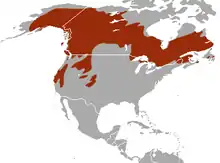 |
Size: 46–66 cm (18–26 in) long, plus 13–16 cm (5–6 in) tail[8] Habitat: Forest[9] Diet: Primarily eats rodents and small mammals, as well as birds, insects, fruit, and carrion[9] |
LC
|
| Beech marten
|
M. foina Erxleben, 1777 Eleven subspecies
|
Europe and central Asia |
Size: 40–50 cm (16–20 in) long, plus 22–30 cm (9–12 in) tail[10] Habitat: Forest, rocky areas, and shrubland[11] Diet: Primarily eats rodents and small mammals, as well as birds, insects, fruit, and carrion[11] |
LC
|
| European pine marten
|
M. martes Linnaeus, 1758 Seven subspecies
|
Europe and west Asia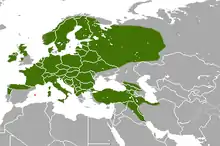 |
Size: 48–58 cm (19–23 in) long, plus 16–28 cm (6–11 in) tail[12] Habitat: Forest and shrubland[13] Diet: Primarily eats small mammals, birds, and amphibians, as well as carrion[13] |
LC
|
| Japanese marten
|
M. melampus Wagner, 1841 Two subspecies
|
Japan (M. m. melampus in green, M. m. tsuensis in red (Tsushima Island)) |
Size: 47–55 cm (19–22 in) long, plus 17–22 cm (7–9 in) tail[14] Habitat: Forest and shrubland[15] Diet: Primarily eats fruit, small mammals, and insects[15] |
LC
|
| Nilgiri marten
|
M. gwatkinsii Horsfield, 1851 |
Parts of southern India |
Size: 55–65 cm (22–26 in) long, plus 40–45 cm (16–18 in) tail[16] Habitat: Forest and grassland[17] Diet: Primarily eats birds, small mammals, and insects[17] |
VU
|
| Sable
|
M. zibellina Linnaeus, 1758 Sixteen subspecies
|
Large parts of Russia |
Size: 38–56 cm (15–22 in) long, plus 9–12 cm (4–5 in) tail[18] Habitat: Forest[19] Diet: Primarily eats small mammals, birds, nuts, and berries[19] |
LC
|
| Yellow-throated marten
|
M. flavigula Boddaert, 1785 Nine subspecies
|
Eastern and southeastern Asia |
Size: 50–72 cm (20–28 in) long, plus 33–48 cm (13–19 in) tail[20] Habitat: Forest and grassland[21] Diet: Primarily eats birds, small mammals, and insects[21] |
LC
|
| Common name | Scientific name and subspecies | Range | Size and ecology | IUCN status and estimated population |
|---|---|---|---|---|
| Fisher
|
P. pennanti Erxleben, 1777 |
Northern North America |
Size: 75–120 cm (30–47 in) long, plus 31–41 cm (12–16 in) tail[22] Habitat: Forest[23] Diet: Primarily eats small to medium mammals, birds, and carrion[23] |
LC
|
Subfamily Helictidinae
| Common name | Scientific name and subspecies | Range | Size and ecology | IUCN status and estimated population |
|---|---|---|---|---|
| Bornean ferret-badger | M. everetti Thomas, 1895 |
Small parts of Borneo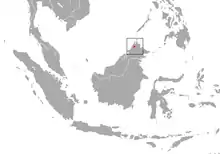 |
Size: 33–44 cm (13–17 in) long, plus 15–23 cm (6–9 in) tail[24] Habitat: Forest and shrubland[25] Diet: Primarily eats invertebrates, amphibians, insects, fruit, and carrion[24][25] |
EN
|
| Burmese ferret-badger
|
M. personata I. Saint-Hilaire, 1831 Five subspecies
|
Southeast Asia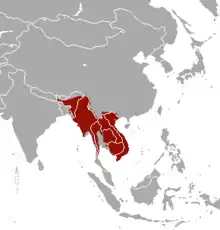 |
Size: 33–44 cm (13–17 in) long, plus 15–23 cm (6–9 in) tail[26] Habitat: Grassland, shrubland, and forest[27] Diet: Primarily eats insects and snails, as well as small mammals, frogs, lizards, carrion, birds, eggs, and fruit[26][27] |
LC
|
| Chinese ferret-badger
|
M. moschata Gray, 1831 Seven subspecies
|
East Asia |
Size: 30–43 cm (12–17 in) long, plus 15–21 cm (6–8 in) tail[28] Habitat: Forest, shrubland, and grassland[29] Diet: Primarily eats insects, frogs, and carrion[29] |
LC
|
| Javan ferret-badger
|
M. orientalis Blanford, 1888 Two subspecies
|
Parts of Java and Indonesia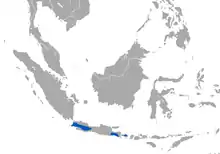 |
Size: 35–40 cm (14–16 in) long, plus 14–17 cm (6–7 in) tail[30] Habitat: Shrubland and forest[31] Diet: Primarily eats invertebrates and insects[30][31] |
LC
|
| Vietnam ferret-badger | M. cucphuongensis T. Nadler, 2011 |
Vietnam | Size: Unknown Habitat: Forest[32] Diet: Unknown[32] |
DD
|
Subfamily Ictonychinae
| Common name | Scientific name and subspecies | Range | Size and ecology | IUCN status and estimated population |
|---|---|---|---|---|
| Greater grison
|
G. vittata Schreber, 1776 Four subspecies
|
Northern South America and Central America |
Size: 60–76 cm (24–30 in) long, including tail[33] Habitat: Forest and grassland[34] Diet: Primarily eats small mammals, birds, lizards, amphibians, eggs, and fruit[34] |
LC
|
| Lesser grison
|
G. cuja Molina, 1782 Four subspecies
|
Southern South America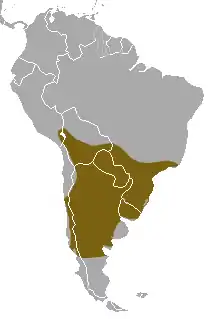 |
Size: 28–51 cm (11–20 in) long, plus 12–20 cm (5–8 in) tail[35] Habitat: Inland wetlands, forest, grassland, and savanna[36] Diet: Primarily eats small lagomorphs and rodents, as well as birds, frogs, lizards, snakes, and eggs[36] |
LC
|
| Common name | Scientific name and subspecies | Range | Size and ecology | IUCN status and estimated population |
|---|---|---|---|---|
| Striped polecat
|
I. striatus Molina, 1782 Nineteen subspecies
|
Central, Southern, and sub-Saharan Africa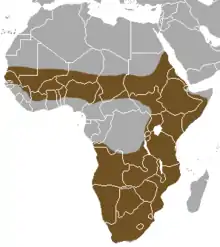 |
Size: 28–30 cm (11–12 in) long, plus 20–30 cm (8–12 in) tail[37] Habitat: Grassland, savanna, desert, and shrubland[38] Diet: Primarily eats insects[38] |
LC
|
| Saharan striped polecat
|
I. libycus Hemprich and Ehrenberg, 1833 Four subspecies
|
Northern, western, and southern edges of the Sahara |
Size: 40–47 cm (16–19 in) long, plus 16–19 cm (6–7 in) tail[39] Habitat: Shrubland and desert[40] Diet: Primarily eats rodents, small mammals, birds, fish, and insects[39][40] |
LC
|
| Common name | Scientific name and subspecies | Range | Size and ecology | IUCN status and estimated population |
|---|---|---|---|---|
| Patagonian weasel
|
L. patagonicus Blainville, 1842 Two subspecies
|
Argentina |
Size: 30–35 cm (12–14 in) long, plus 6–9 cm (2–4 in) tail[41] Habitat: Shrubland, grassland, and forest[42] Diet: Primarily eats rodents and birds[42] |
LC
|
| Common name | Scientific name and subspecies | Range | Size and ecology | IUCN status and estimated population |
|---|---|---|---|---|
| African striped weasel
|
P. albinucha Gray, 1864 Five subspecies
|
Southern Africa |
Size: 25–36 cm (10–14 in) long, plus 13–23 cm (5–9 in) tail[43] Habitat: Shrubland, forest, savanna, and grassland[44] Diet: Primarily eats small mammals, rodents, and birds, as well as snakes and insects[43][44] |
LC
|
| Common name | Scientific name and subspecies | Range | Size and ecology | IUCN status and estimated population |
|---|---|---|---|---|
| Marbled polecat
|
V. peregusna Güldenstädt, 1864 Five subspecies
|
Southeast Europe and central Asia |
Size: 28–48 cm (11–19 in) long, plus 14–20 cm (6–8 in) tail[45] Habitat: Desert, rocky areas, grassland, and shrubland[46] Diet: Primarily eats rodents and birds[46] |
VU
|
Subfamily Lutrinae
| Common name | Scientific name and subspecies | Range | Size and ecology | IUCN status and estimated population |
|---|---|---|---|---|
| African clawless otter
|
A. capensis Schinz, 1821 Six subspecies
|
Sub-Saharan Africa |
Size: 72–95 cm (28–37 in) long, plus 40–60 cm (16–24 in) tail[47] Habitat: Forest, inland wetlands, neritic marine, coastal marine, intertidal marine, and grassland[48] Diet: Primarily eats crabs and lobsters, as well as frogs, fish, and insects[47][48] |
NT
|
| Asian small-clawed otter
|
A. cinerea Illiger, 1815 Three subspecies
|
Southeast Asia |
Size: 40–63 cm (16–25 in) long, plus 25–35 cm (10–14 in) tail[49] Habitat: Intertidal marine, coastal marine, inland wetlands, forest, shrubland, neritic marine, and grassland[50] Diet: Primarily eats crabs, molluscs, insects, and small fish, as well as rodents, snakes, and amphibians[50] |
VU
|
| Common name | Scientific name and subspecies | Range | Size and ecology | IUCN status and estimated population |
|---|---|---|---|---|
| Sea otter
|
E. lutris Linnaeus, 1758 Three subspecies
|
Western North American coast, eastern Russian coast, northern Japanese coast |
Size: 55–130 cm (22–51 in) long, plus 12–33 cm (5–13 in) tail[51] Habitat: Neritic marine and oceanic marine[52] Diet: Primarily eats marine invertebrates, as well as fish[52] |
EN
|
| Common name | Scientific name and subspecies | Range | Size and ecology | IUCN status and estimated population |
|---|---|---|---|---|
| Spotted-necked otter
|
H. maculicollis Lichtenstein, 1835 |
Much of sub-Saharan Africa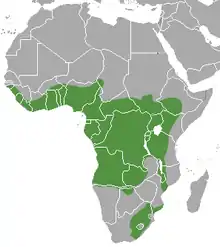 |
Size: 57–69 cm (22–27 in) long, plus 33–44 cm (13–17 in) tail[53] Habitat: Inland wetlands, neritic marine, forest, coastal marine, and intertidal marine[54] Diet: Primarily eats frogs, crabs and small water birds[53][54] |
NT
|
| Common name | Scientific name and subspecies | Range | Size and ecology | IUCN status and estimated population |
|---|---|---|---|---|
| North American river otter
|
L. canadensis Schreber, 1777 Seven subspecies
|
Canada and eastern and western America |
Size: 66–107 cm (26–42 in) long, plus 31–46 cm (12–18 in) tail[55] Habitat: Inland wetlands, intertidal marine, neritic marine, and coastal marine[56] Diet: Primarily eats fish, as well as amphibians and crustaceans[56] |
LC
|
| Southern river otter
|
L. provocax Thomas, 1908 |
Southern Chile and Argentina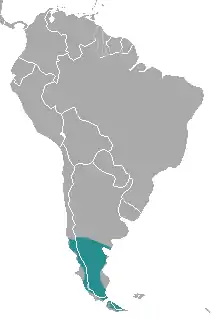 |
Size: 57–70 cm (22–28 in) long, plus 35–46 cm (14–18 in) tail[57] Habitat: Inland wetlands, coastal marine, neritic marine, and intertidal marine[58] Diet: Primarily eats fish and crustaceans[58] |
EN
|
| Neotropical otter
|
L. longicaudis Olfers, 1818 Three subspecies
|
South and Central America |
Size: 50–79 cm (20–31 in) long, plus 37–57 cm (15–22 in) tail[59] Habitat: Coastal marine, inland wetlands, neritic marine, and intertidal marine[60] Diet: Primarily eats fish, as well as crustaceans, insects, amphibians, and molluscs[60] |
NT
|
| Marine otter
|
L. felina Molina, 1782 |
West coast of South America |
Size: 57–79 cm (22–31 in) long, plus 30–36 cm (12–14 in) tail[61] Habitat: Coastal marine, intertidal marine, oceanic marine, and neritic marine[62] Diet: Primarily eats crustaceans and molluscs, as well as fish, birds, and small mammals[62] |
EN
|
| Common name | Scientific name and subspecies | Range | Size and ecology | IUCN status and estimated population |
|---|---|---|---|---|
| Eurasian otter
|
L. lutra Linnaeus, 1758 Twelve subspecies
|
Europe, north Africa, and large regions of Asia |
Size: 57–70 cm (22–28 in) long, plus 35–40 cm (14–16 in) tail[63] Habitat: Inland wetlands, forest, grassland, coastal marine, neretic marine, intertidal marine, and shrubland[64] Diet: Primarily eats fish, as well as insects, reptiles, amphibians, birds, small mammals, and crustaceans[64] |
NT
|
| Hairy-nosed otter
|
L. sumatrana Gray, 1865 |
Scattered parts of southeast Asia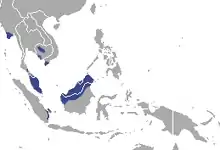 |
Size: 50–82 cm (20–32 in) long, plus 35–50 cm (14–20 in) tail[65] Habitat: Inland wetlands, neritic marine, shrubland, grassland, forest, coastal marine, and intertidal marine[66] Diet: Primarily eats fish and water snakes, as well as frogs, lizards, turtles, and crabs[66] |
EN
|
| Common name | Scientific name and subspecies | Range | Size and ecology | IUCN status and estimated population |
|---|---|---|---|---|
| Smooth-coated otter
|
L. perspicillata Geoffroy Saint-Hilaire, 1826 Three subspecies
|
South and southeast Asia |
Size: 65–79 cm (26–31 in) long, plus 40–50 cm (16–20 in) tail[67] Habitat: Inland wetlands, forest, grassland, coastal marine, neritic marine, intertidal marine, and shrubland[68] Diet: Primarily eats fish, as well as shrimp, crabs, and insects[68] |
VU
|
| Common name | Scientific name and subspecies | Range | Size and ecology | IUCN status and estimated population |
|---|---|---|---|---|
| Giant otter
|
P. brasiliensis Gmelin, 1788 Two subspecies
|
North and central South America |
Size: 96–123 cm (38–48 in) long, plus 45–65 cm (18–26 in) tail[69] Habitat: Inland wetlands, coastal marine, neritic marine, and forest[70] Diet: Primarily eats fish, as well as caiman and turtles[70] |
EN
|
Subfamily Melinae
| Common name | Scientific name and subspecies | Range | Size and ecology | IUCN status and estimated population |
|---|---|---|---|---|
| Hog badger
|
A. collaris F. Cuvier, 1825 Six subspecies
|
East and southeast Asia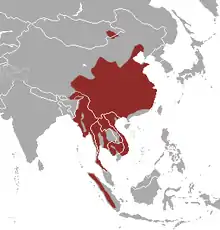 |
Size: 55–70 cm (22–28 in) long, plus 12–17 cm (5–7 in) tail[71] Habitat: Forest, grassland, shrubland, and savanna[72] Diet: Believed to primarily eat worms[72] |
VU
|
| Common name | Scientific name and subspecies | Range | Size and ecology | IUCN status and estimated population |
|---|---|---|---|---|
| Asian badger
|
M. leucurus Hodgson, 1847 Five subspecies
|
Central and east Asia |
Size: 49–70 cm (19–28 in) long, plus 13–21 cm (5–8 in) tail[73] Habitat: Shrubland, grassland, and forest[74] Diet: Omnivorous; eats fruit, nuts, plants, earthworms, insects, eggs, carrion, and small mammals[74] |
LC
|
| European badger
|
M. meles Linnaeus, 1758 Eight subspecies
|
Europe and west Asia |
Size: 56–90 cm (22–35 in) long, plus 11–20 cm (4–8 in) tail[75] Habitat: Grassland, forest, desert, and shrubland[76] Diet: Omnivorous; eats fruit, nuts, plants, earthworms, insects, eggs, carrion, and small mammals[76] |
LC
|
| Japanese badger
|
M. anakuma Temminck, 1844 |
Japan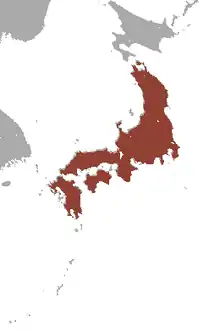 |
Size: 70–79 cm (28–31 in) long, plus 14–20 cm (6–8 in) tail[77] Habitat: Forest[78] Diet: Primarily eats earthworms and insects, as well as fruit[78] |
LC
|
Subfamily Mellivorinae
| Common name | Scientific name and subspecies | Range | Size and ecology | IUCN status and estimated population |
|---|---|---|---|---|
| Honey badger
|
M. capensis Schreber, 1776 Twelve subspecies
|
Africa, Middle East, and India |
Size: 73–96 cm (29–38 in) long, plus 14–23 cm (6–9 in) tail[79] Habitat: Forest, shrubland, savanna, and desert[80] Diet: Primarily eats smaller mammals[80] |
LC
|
Subfamily Mustelinae
| Common name | Scientific name and subspecies | Range | Size and ecology | IUCN status and estimated population |
|---|---|---|---|---|
| Amazon weasel | M. africana Desmarest, 1818 Two subspecies
|
Amazon basin |
Size: 41–52 cm (16–20 in) long, plus 16–21 cm (6–8 in) tail[81] Habitat: Inland wetlands and forest[82] Diet: Unknown[83][82] |
LC
|
| Back-striped weasel
|
M. strigidorsa Gray, 1855 |
Parts of southeast Asia |
Size: 30–36 cm (12–14 in) long, plus 18–20 cm (7–8 in) tail[84] Habitat: Forest and shrubland[85] Diet: Unknown, but believed to eat rodents and insects[84][85] |
LC
|
| Black-footed ferret
|
M. nigripes Audubon, 1851 |
Three small areas in central United States |
Size: 50–53 cm (20–21 in) long, plus 11–13 cm (4–5 in) tail[86] Habitat: Shrubland and grassland[87] Diet: Primarily eats prairie dogs[87] |
EN
|
| Colombian weasel | M. felipei Izor and Torre, 1978 |
Small area of northwest South America |
Size: 32–39 cm (13–15 in) long, plus 10–14 cm (4–6 in) tail[88] Habitat: Inland wetlands and forest[89] Diet: Unknown, but believed to eat fish, small mammals, and insects[90][89] |
VU
|
| Egyptian weasel
|
M. subpalmata Hemprich, 1833 |
Nile river delta in Egypt |
Size: 32–43 cm (13–17 in) long, plus 9–13 cm (4–5 in) tail[91] Habitat: Urban, marine[92] Diet: Primarily eats fruit and vegetables, birds, and insects[93][92] |
LC
|
| European mink
|
M. lutreola Linnaeus, 1761 Seven subspecies
|
Scattered parts of west Asia and west Europe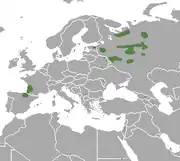 |
Size: 35–43 cm (14–17 in) long, plus 15–19 cm (6–7 in) tail[94] Habitat: Inland wetlands[95] Diet: Primarily eats amphibians, crustaceans, fish, small mammals, insects, and birds[95] |
CR
|
| European polecat
|
M. putorius Linnaeus, 1758 Seven subspecies
|
Europe and west Asia |
Size: 29–46 cm (11–18 in) long, plus 8–17 cm (3–7 in) tail[96] Habitat: Inland wetlands, coastal marine, grassland, forest, and shrubland[97] Diet: Primarily eats lagomorphs, rodents, amphibians, and other vertebrates, as well as invertebrates and carrion[97] |
LC
|
| Indonesian mountain weasel | M. lutreolina Robinson, 1917 |
Scattered parts of Indonesia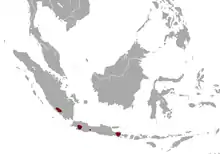 |
Size: 27–33 cm (11–13 in) long, plus 13–17 cm (5–7 in) tail[98] Habitat: Shrubland and forest[99] Diet: Primarily eats rodents, as well as small mammals, birds, amphibians, and eggs[98][99] |
LC
|
| Japanese weasel
|
M. itatsi Temminck, 1844 |
Japan (native range in blue, introduced in red (Hokkaido)) |
Size: 21–36 cm (8–14 in) long, plus 7–16 cm (3–6 in) tail[100] Habitat: Shrubland, grassland, and forest[101] Diet: Primarily eats rodents, insects, amphibians, and reptiles[101] |
NT
|
| Least weasel
|
M. nivalis Linnaeus, 1766 Eighteen subspecies
|
Europe, Asia, northern Africa, northern North America |
Size: 11–26 cm (4–10 in) long, plus 1–9 cm (0–4 in) tail[102] Habitat: Forest, inland wetlands, rocky areas, coastal marine, shrubland, and grassland[103] Diet: Primarily eats rodents and other small mammals as well as eggs, lizards, frogs, salamanders, fish, worms, and carrion[103] |
LC
|
| Long-tailed weasel
|
M. frenata Lichtenstein, 1831 42 subspecies
|
North America, Central America, and northern South America |
Size: 28–42 cm (11–17 in) long, plus 11–30 cm (4–12 in) tail[104] Habitat: Inland wetlands, grassland, and shrubland[105] Diet: Primarily eats rodents and other small mammals[105] |
LC
|
| Malayan weasel | M. nudipes Desmarest, 1822 Two subspecies
|
Southeast Asia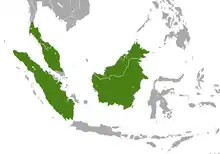 |
Size: 30–36 cm (12–14 in) long, plus 24–26 cm (9–10 in) tail[106] Habitat: Shrubland and forest[107] Diet: Primarily eats rodents, as well as small birds, lizards, and insects[106][107] |
LC
|
| Mountain weasel
|
M. altaica Pallas, 1811 Four subspecies
|
Central Asia and northern India | Size: 22–29 cm (9–11 in) long, plus 9–15 cm (4–6 in) tail[108] Habitat: Shrubland, rocky areas, and grassland[109] Diet: Primarily eats pikas, rodents, small birds, lizards, and insects[109] |
NT
|
| Siberian weasel
|
M. sibirica Pallas, 1773 Eleven subspecies
|
North-central and east Asia (native range in green, introduced in red (Japan))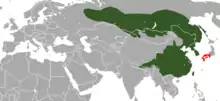 |
Size: 25–39 cm (10–15 in) long, plus 13–21 cm (5–8 in) tail[110] Habitat: Grassland, shrubland, forest, and rocky areas[111] Diet: Primarily eats small mammals, amphibians, fish, carrion, and pine nuts[111] |
LC
|
| Steppe polecat
|
M. eversmanii Lesson, 1827 Seven subspecies
|
Central Asia and eastern Europe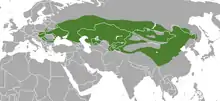 |
Size: 29–56 cm (11–22 in) long, plus 8–18 cm (3–7 in) tail[112] Habitat: Grassland and shrubland[113] Diet: Primarily eats rodents and pikas[113] |
LC
|
| Stoat
|
M. erminea Linnaeus, 1758 37 subspecies
|
Europe, north Asia, northern North America, and Greenland (native range in green, introduced in red (New Zealand)) |
Size: 17–33 cm (7–13 in) long, plus 4–12 cm (2–5 in) tail[114] Habitat: Shrubland, inland wetlands, grassland, rocky areas, and forest[115] Diet: Primarily eats small mammals, as well as fruit, earthworms, insects, eggs, and birds[115] |
LC
|
| Yellow-bellied weasel
|
M. kathiah Hodgson, 1835 Two subspecies
|
Himalayan mountains and east-southeast Asia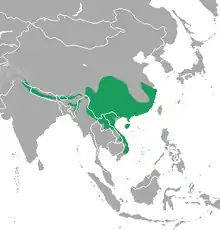 |
Size: 25–27 cm (10–11 in) long, plus 12–15 cm (5–6 in) tail[116] Habitat: Forest, shrubland, and grassland[117] Diet: Primarily eats rodents, as well as birds and small mammals[116][117] |
LC
|
| Common name | Scientific name and subspecies | Range | Size and ecology | IUCN status and estimated population |
|---|---|---|---|---|
| American mink
|
N. vison Schreber, 1777 Fifteen subspecies
|
Canada and United States, and large areas in South America, Europe, and Asia (native range in red (North America), introduced in pink) |
Size: 31–45 cm (12–18 in) long, plus 14–25 cm (6–10 in) tail[118] Habitat: Inland wetlands, forest, and shrubland[119] Diet: Primarily eats fish, amphibians, crustaceans, muskrats, and small mammals[119] |
LC
|
| Sea mink
|
N. macrodon Prentiss, 1903 |
Northeast United States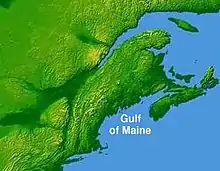 |
Size: Estimated to have been around 91 cm (36 in) long, plus 25 cm (10 in) tail[120] Habitat: Intertidal marine, neritic marine, and coastal marine[121] Diet: Primarily ate fish as well as molluscs[121] |
EX
|
Subfamily Taxidiinae
| Common name | Scientific name and subspecies | Range | Size and ecology | IUCN status and estimated population |
|---|---|---|---|---|
| American badger
|
T. taxus Schreber, 1777 Five subspecies
|
United States and southern Canada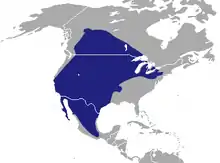 |
Size: 42–72 cm (17–28 in) long, plus 10–16 cm (4–6 in) tail[122] Habitat: Forest, grassland, and shrubland[123] Diet: Primarily eats fossorial rodents, as well as scorpions, insects, snakes, lizards, and birds[123] |
LC
|
Prehistoric mustelids
In addition to extant mustelids, a number of prehistoric species have been discovered and classified as a part of Mustelidae. Morphogenic and molecular phylogenic research has placed them within the extant subfamilies Guloninae, Ictonychinae, Lutrinae, Melinae, Mellivorinae, Mustelinae, and Taxidiinae, as well as the extinct subfamilies Leptarctinae, Mustelavinae, and Oligobuninae. There is no generally accepted classification of extinct mustelid species, and many discovered species have not been placed within any subfamily. The species listed here are based on data from the Paleobiology Database, unless otherwise cited. Where available, the approximate time period the species was extant is given in millions of years before the present (Mya), also based on data from the Paleobiology Database.[124] All listed species are extinct; where a genus or subfamily within Mustelidae comprises only extinct species, it is indicated with a dagger symbol ![]() .
.
- Subfamily Guloninae
- Genus Canimartes

- C. cumminsii
- Genus Ferinestrix
 (4.9–1.8 Mya)
(4.9–1.8 Mya)
- F. vorax (4.9–1.8 Mya)
- Genus Gulo
- G. diaphorus
- G. primigenius (12–5.3 Mya)
- G. sudorus (11–1.8 Mya)
- Genus Iberictis
 (16–11 Mya)
(16–11 Mya)
- I. azanzae (16–11 Mya)
- I. buloti (16–13 Mya)
- Genus Ischyrictis
 (16–12 Mya)
(16–12 Mya) - Genus Pekania
- P. diluviana (1.8–0.3 Mya)
- P. occulta (11–4.9 Mya)
- P. palaeosinensis
- Genus Plesiogulo
 (11–4.9 Mya)
(11–4.9 Mya)
- P. lindsayi (11–4.9 Mya)
- P. marshalli (11–4.9 Mya)
- Genus Plionictis
 (16–4.9 Mya)
(16–4.9 Mya)
- P. oaxacaensis (16–13 Mya)
- P. ogygia (16–10 Mya)
- P. oregonensis (11–4.9 Mya)
- Genus Sthenictis

- S. bellus (21–15 Mya)
- S. dolichops (16–13 Mya)
- S. junturensis (23–5.3 Mya)
- S. lacota (14–10 Mya)
- S. robustus
- Genus Canimartes
- Subfamily Ictonychinae
- Genus Cernictis
 (11–4.9 Mya)
(11–4.9 Mya)
- C. hesperus (11–4.9 Mya)
- C. repenningi (11–4.9 Mya)
- Genus Enhydrictis
 (2.6–0.12 Mya)
(2.6–0.12 Mya)
- E. ardea (2.6–0.12 Mya)
- Genus Lutravus
 (10.3–4.9 Mya)
(10.3–4.9 Mya)
- L. halli (10.3–4.9 Mya)
- Genus Oriensictis

- Genus Pannonictis
 (2.6–0.78 Mya)
(2.6–0.78 Mya)
- P. pliocaenica (2.6–0.78 Mya)
- Genus Sminthosinis
 (4.9–1.8 Mya)
(4.9–1.8 Mya)
- S. bowleri (4.9–1.8 Mya)
- Genus Stipanicicia
 (1.2–0.78 Mya)
(1.2–0.78 Mya) - Genus Trigonictis
 (1.8–0.3 Mya)
(1.8–0.3 Mya)
- T. cookii (1.8–0.3 Mya)
- T. macrodon (1.8–0.78 Mya)
- Genus Trochictis
 (15–9.7 Mya)
(15–9.7 Mya)
- Genus Cernictis
- Subfamily Leptarctinae

- Genus Craterogale

- C. simus (21–15 Mya)
- Genus Leptarctus

- L. ancipidens (16–13 Mya)
- L. martini (16–13 Mya)
- L. mummorum (14–10 Mya)
- L. neimenguensis
- L. oregonensis (16–13 Mya)
- L. primus (16–13 Mya)
- L. progressus
- L. supremus (11–4.9 Mya)
- L. webbi (14–10 Mya)
- L. woodburnei (11–5.3 Mya)
- L. wortmani (14–10 Mya)
- Genus Trocharion

- T. albanense (16–11 Mya)
- Genus Craterogale
- Subfamily Lutrinae
- Genus Aonyx
- A. antiqua (0.79–0.12 Mya)
- Genus Cyrnaonyx
 (0.79–0.12 Mya)
(0.79–0.12 Mya)
- C. antiqua (0.79–0.12 Mya)
- Genus Enhydra
- E. macrodonta (0.3–0.012 Mya)
- E. reevei (2.6–1.8 Mya)
- Genus Enhydriodon

- E. aethiopicus
- E. africanus (3.6–2.5 Mya)
- E. dikikae (5.4–3.6 Mya)
- E. ekecaman (5.4–3.6 Mya)
- E. falconeri (5.4–2.5 Mya)
- E. latipes
- E. sivalensis (3.6–2.5 Mya)
- E. hendeyi[125]
- Genus Lontra
- L. weiri (5.4–2.5 Mya)
- Genus Lutra
- L. affinis (5.4–2.5 Mya)
- L. bravardi (2.6–1.8 Mya)
- L. bressana (2.6–0.012 Mya)
- L. castiglionis (0.79–0.12 Mya)
- L. fatimazohrae (3.6–2.5 Mya)
- L. franconica (29–23 Mya)
- L. hessica
- L. licenti
- L. lybica
- L. maculicollis (0.13–0.012 Mya)
- L. palaeoleptonyx
- L. simplicidens (0.79–0.12 Mya)
- L. sumatrana
- Genus Lutraeximia
 (2.6–0.012 Mya)
(2.6–0.012 Mya)
- L. trinacriae (2.6–0.012 Mya)
- L. umbra (2.6–0.78 Mya)
- Genus Lutrictis

- L. lycopotamicus
- Genus Lutrogale
- L. cretensis (0.13–0.012 Mya)
- Genus Megencephalon

- M. primaevus
- Genus Nesolutra
 (2.6–0.12 Mya)
(2.6–0.12 Mya)
- N. euxena (2.6–0.12 Mya)
- Genus Paludolutra
 (8.7–3.2 Mya)
(8.7–3.2 Mya)
- P. campanii (8.7–5.3 Mya)
- P. lluecai (5.4–3.2 Mya)
- P. maremmana (8.7–5.3 Mya)
- Genus Sardolutra
 (2.6–0.12 Mya)
(2.6–0.12 Mya)
- S. ichnusae (2.6–0.12 Mya)
- Genus Siamogale

- S. melilutra (12–4.9 Mya)
- S. thailandica
- Genus Teruelictis
 (9.7–8.7 Mya)
(9.7–8.7 Mya)
- T. riparius (9.7–8.7 Mya)
- Genus Tyrrhenolutra

- T. helbingi (8.7–5.3 Mya)
- Genus Aonyx
- Subfamily Melinae
- Genus Algarolutra
 (2.6–0.012 Mya)
(2.6–0.012 Mya)
- A. majori (2.6–0.012 Mya)
- Genus Arctomeles
 (11–1.8 Mya)
(11–1.8 Mya)
- A. dimolodontus (11–1.8 Mya)
- A. sotnikovae (5.4–3.6 Mya)
- Genus Cyrnolutra

- Genus Enhydritherium
 (14–4.9 Mya)
(14–4.9 Mya)
- E. terraenovae (14–4.9 Mya)
- Genus Meles
- M. iberica (2.6–0.78 Mya)
- M. thorali (2.6–1.8 Mya)
- Genus Limnonyx

- L. pontica (12–5.3 Mya)
- L. sinerizi
- Genus Megalenhydris
 (0.13–0.012 Mya)
(0.13–0.012 Mya)
- M. barbaricina (0.13–0.012 Mya)
- Genus Melodon
 (16–5.3 Mya)
(16–5.3 Mya) - Genus Mionictis
 (21–7.2 Mya)
(21–7.2 Mya)
- M. angustidens (14–10 Mya)
- M. artenensis (17–15 Mya)
- M. dubia (12–7.2 Mya)
- M. elegans (21–15 Mya)
- M. incertus (21–15 Mya)
- M. letifer (21–15 Mya)
- M. pristinus (14–10 Mya)
- Genus Paralutra

- P. garganensis (12–5.3 Mya)
- P. jaegeri (12–9.7 Mya)
- P. lorteti (17–15 Mya)
- P. transdanubica
- Genus Pelycictis

- Genus Promeles
 (8.7–5.3 Mya)
(8.7–5.3 Mya) - Genus Satherium

- S. ingens
- S. piscinarium (4.9–0.3 Mya)
- Genus Algarolutra
- Subfamily Mellivorinae
- Genus Ekorus
 (12–7.2 Mya)
(12–7.2 Mya)
- E. ekakeran (12–7.2 Mya)
- Genus Eomellivora
 (12–7.2 Mya)
(12–7.2 Mya)
- Genus Hoplictis
 (14–10 Mya)
(14–10 Mya)
- H. grangerensis (14–10 Mya)
- Genus Mellivora
- M. punjabiensis (3.6–2.5 Mya)
- Genus Ekorus
- Subfamily Mustelinae
- Genus Baranogale

- B. antiqua (2.6–1.8 Mya)
- B. balcanica
- B. helbingi (7.3–2.5 Mya)
- Genus Dinogale
 (21–15 Mya)
(21–15 Mya)
- D. siouxensis (21–15 Mya)
- Genus Lartetictis
 (14–2.5 Mya)
(14–2.5 Mya)
- L. dubia (14–2.5 Mya)
- Genus Legionarictis
 (16–13 Mya)
(16–13 Mya)
- L. fortidens (16–13 Mya)
- Genus Martes
- M. campestris (14–10 Mya)
- M. caurina
- M. foxi (4.9–1.8 Mya)
- M. gazini (16–13 Mya)
- M. intermedius
- M. khelifensis (16–11 Mya)
- M. kinseyi (16–13 Mya)
- M. melampus
- M. parviloba (16–13 Mya)
- M. stirtoni (14–10 Mya)
- M. vetus (2.6–0.78 Mya)
- Genus Mustela
- M. buwaldi
- M. eversmannii (0.78–0.012 Mya)
- M. furo
- M. jacksoni (2.6–0.78 Mya)
- M. meltoni (4.9–1.8 Mya)
- M. ogygia
- M. palaeattica (12–7.2 Mya)
- M. palermina
- M. praenivalis (2.6–0.12 Mya)
- M. rexroadensis (4.9–1.8 Mya)
- M. spelaea
- Genus Putorius

- P. nambianus
- P. stromeri (2.6–0.78 Mya)
- Genus Tisisthenes
 (1.8–0.3 Mya)
(1.8–0.3 Mya)
- T. parvus (1.8–0.3 Mya)
- Genus Vormela
- V. beremendensis
- Genus Baranogale
- Subfamily Mustelavinae

- Genus Mustelavus
 (34–24 Mya)
(34–24 Mya)
- M. priscus (34–24 Mya)
- Genus Mustelavus
- Subfamily Oligobuninae

- Genus Brachypsalis
 (24–5.3 Mya)
(24–5.3 Mya)
- B. hyaenoides (24–5.3 Mya)
- B. matutinus (21–15 Mya)
- B. modicus (16–13 Mya)
- B. obliquidens (16–13 Mya)
- B. pachycephalus (16–13 Mya)
- Genus Corumictis
 (34–28 Mya)[127]
(34–28 Mya)[127]
- C. wolsani (34–28 Mya)[127]
- Genus Floridictis
 (21–15 Mya)
(21–15 Mya)
- F. kerneri (21–15 Mya)
- Genus Megalictis

- M. ferox (25–20 Mya)
- M. frazieri (25–20 Mya)
- M. petersoni
- Genus Oligobunis
 (24–15 Mya)
(24–15 Mya)
- O. crassivultus (24–15 Mya)
- O. floridanus (21–15 Mya)
- Genus Parabrachypsalis
 (21–15 Mya)
(21–15 Mya)
- P. janisae (21–15 Mya)
- Genus Paroligobunis

- Genus Promartes

- P. darbyi (27–24 Mya)
- P. fossor
- P. gemmarosae (31–20 Mya)
- P. lepidus (21–15 Mya)
- P. olcotti (25–20 Mya)
- P. vantasselensis (25–20 Mya)
- Genus Zodiolestes
 (25–15 Mya)
(25–15 Mya)
- Z. daimonelixensis (25–20 Mya)
- Z. freundi (21–15 Mya)
- Genus Brachypsalis
- Subfamily Taxidiinae
- Genus Chamitataxus
 (11–4.9 Mya)
(11–4.9 Mya)
- C. avitus (11–4.9 Mya)
- Genus Pliotaxidea

- P. garberi (11–4.9 Mya)
- P. nevadensis (11–5.3 Mya)
- Genus Taxidea
- T. mexicana (11–4.9 Mya)
- Genus Chamitataxus
- Unclassified
- Genus Acheronictis
 (31–20 Mya)
(31–20 Mya)
- A. webbi (31–20 Mya)
- Genus Arikarictis
 (25–20 Mya)
(25–20 Mya)
- A. chapini (25–20 Mya)
- Genus Brevimalictis
 (16–13 Mya)
(16–13 Mya)
- B. chikasha (16–13 Mya)
- Genus Circamustela
 (12–8.7 Mya)
(12–8.7 Mya) - Genus Erokomellivora
 (11–2.6 Mya)
(11–2.6 Mya) - Genus Franconictis

- F. huilidens
- F. vireti (23–20 Mya)
- Genus Kenyalutra

- Genus Kinometaxia

- Genus Laphyctis

- Genus Luogale

- Genus Marcetia
 (12–8.7 Mya)
(12–8.7 Mya) - Genus Matanomictis
 (29–23 Mya)
(29–23 Mya)
- M. maniyarensis (29–23 Mya)
- Genus Melidellavus
 (16–11 Mya)
(16–11 Mya) - Genus Mellalictis
 (16–11 Mya)
(16–11 Mya)
- M. mellalensis (16–11 Mya)
- Genus Mesomephitis

- Genus Miomustela
 (16–13 Mya)
(16–13 Mya)
- M. madisonae (16–13 Mya)
- Genus Mustelictis

- M. olivieri (34–28 Mya)
- M. robustus
- Genus Namibictis
 (24–11 Mya)
(24–11 Mya)
- N. senuti (24–11 Mya)
- Genus Negodiaetictis
 (16–13 Mya)
(16–13 Mya)
- N. rugatrulleum (16–13 Mya)
- Genus Palaeomeles

- Genus Paragale

- Genus Parataxidea
 (16–2.5 Mya)
(16–2.5 Mya) - Genus Perunium

- Genus Plesictis
 (29–20 Mya)
(29–20 Mya) - Genus Plesiogale
 (24–5.3 Mya)
(24–5.3 Mya)
- P. postfelina (24–5.3 Mya)
- Genus Plesiomeles

- Genus Poecilictis
 (3.6–2.5 Mya)
(3.6–2.5 Mya) - Genus Prepoecilogale

- Genus Presictis

- Genus Promellivora

- Genus Proputorius
 (16–7.2 Mya)
(16–7.2 Mya) - Genus Protarctos
 (5.4–2.5 Mya)
(5.4–2.5 Mya) - Genus Pyctis
 (34–28 Mya)
(34–28 Mya)
- P. inamatus (34–28 Mya)
- Genus Sabadellictis

- Genus Semantor
 (5.4–2.5 Mya)
(5.4–2.5 Mya)
- S. macrurus (5.4–2.5 Mya)
- Genus Sinictis

- Genus Sivalictis

- Genus Sivaonyx

- S. bathygnatha
- S. gandakasensis (12–7.2 Mya)
- S. hendeyi (24–2.5 Mya)
- S. hessicus (12–5.3 Mya)
- S. kamuhangirei (5.4–3.6 Mya)
- S. lehmani (8.7–5.3 Mya)
- S. senutae (12–5.3 Mya)
- S. soriae (7.3–5.3 Mya)
- Genus Taxodon
 (16–9.7 Mya)
(16–9.7 Mya) - Genus Torolutra
 (5.4–3.6 Mya)
(5.4–3.6 Mya) - Genus Trochotherium
 (13–11 Mya)
(13–11 Mya) - Genus Vishnuonyx
 (16–11 Mya)
(16–11 Mya)
- V. chinjiensis (16–11 Mya)
- Genus Xenictis
 (2.6–0.78 Mya)
(2.6–0.78 Mya) - Genus Zorilla

- Genus Acheronictis
 Fossil of Aonyx antiqua
Fossil of Aonyx antiqua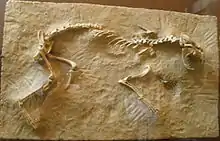 Fossil of Sthenictis species
Fossil of Sthenictis species Restoration of Chamitataxus avitus
Restoration of Chamitataxus avitus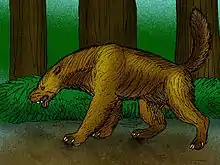 Restoration of Ekorus ekakeran
Restoration of Ekorus ekakeran Restoration of Megalictis ferox
Restoration of Megalictis ferox
References
- Law, C. J.; Slater, G. J.; Mehta, R. S. (January 2018). "Lineage Diversity and Size Disparity in Musteloidea: Testing Patterns of Adaptive Radiation Using Molecular and Fossil-Based Methods". Systematic Biology. 67 (1): 127–144. doi:10.1093/sysbio/syx047. PMID 28472434.
- Koepfli, K. P.; Kanchanasaka, B.; Sasaki, H.; Jacques, H.; Louie, K. D. Y.; Hoai, T.; Dang, N. X.; Geffen, E.; Gutleb, A.; Han, S.; Heggberget, T. M.; LaFontaine, L.; Lee, H.; Melisch, R.; Ruiz-Olmo, J.; Santos-Reis, M.; Sidorovich, V. E.; Stubbe, M.; Wayne, R. K. (2008). "Establishing the foundation for an applied molecular taxonomy of otters in Southeast Asia" (PDF). Conservation Genetics. 9 (6): 1589–1604. doi:10.1007/s10592-007-9498-5. S2CID 24619297.
- Jacques, Hélène; et al. (2009). "The Congo clawless otter (Aonyx congicus) (Mustelidae: Lutrinae): a review of its systematics, distribution and conservation status". African Zoology. 44 (2): 159–170. doi:10.3377/004.044.0204. S2CID 86008709.
- Schreffler, Christina (2003). "Eira barbara". Animal Diversity Web. University of Michigan. Retrieved November 13, 2019.
- Cuarón, A. D.; Reid, F.; Helgen, K.; González-Maya, J. F. (2016). "Eira barbara". IUCN Red List of Threatened Species. 2016: e.T41644A45212151. doi:10.2305/IUCN.UK.2016-1.RLTS.T41644A45212151.en.
- Streubel, Donald (2000). "Wolverine". Digital Atlas of Idaho. Idaho State University. Archived from the original on August 22, 2016. Retrieved October 2, 2019.
- Abramov, A. V. (2016). "Gulo gulo". IUCN Red List of Threatened Species. 2016: e.T9561A45198537. doi:10.2305/IUCN.UK.2016-1.RLTS.T9561A45198537.en.
- Streubel, Donald (2000). "American Marten". Digital Atlas of Idaho. Idaho State University. Archived from the original on August 22, 2016. Retrieved October 2, 2019.
- Helgen, K.; Reid, F. (2016). "Martes americana". IUCN Red List of Threatened Species. 2016: e.T41648A45212861. doi:10.2305/IUCN.UK.2016-1.RLTS.T41648A45212861.en.
- Carter, Kimberlee (2004). "Martes foina". Animal Diversity Web. University of Michigan. Retrieved November 13, 2019.
- Abramov, A. V.; Kranz, A.; Herrero, J.; Choudhury, A.; Maran, T. (2016). "Martes foina". IUCN Red List of Threatened Species. 2016: e.T29672A45202514. doi:10.2305/IUCN.UK.2016-1.RLTS.T29672A45202514.en.
- Schwanz, Lisa (2000). "Martes martes". Animal Diversity Web. University of Michigan. Retrieved November 13, 2019.
- Herrero, J.; Kranz, A.; Skumatov, D.; Abramov, A. V.; Maran, T.; Monakhov, V. G. (2016). "Martes martes". IUCN Red List of Threatened Species. 2016: e.T12848A45199169. doi:10.2305/IUCN.UK.2016-1.RLTS.T12848A45199169.en.
- Barthen, Bill (2003). "Martes melampus". Animal Diversity Web. University of Michigan. Retrieved November 13, 2019.
- Abramov, A. V.; Kaneko, Y.; Masuda, R. (2015). "Martes melampus". IUCN Red List of Threatened Species. 2015: e.T41650A45213228. doi:10.2305/IUCN.UK.2015-4.RLTS.T41650A45213228.en.
- Webb, Amanda (2013). "Martes gwatkinsii". Animal Diversity Web. University of Michigan. Retrieved November 13, 2019.
- Mudappa, D.; Jathana, D.; Raman, T. R. S. (2015). "Martes gwatkinsii". IUCN Red List of Threatened Species. 2015: e.T12847A45199025. doi:10.2305/IUCN.UK.2015-4.RLTS.T12847A45199025.en.
- Bates, Jeremy (2002). "Martes zibellina". Animal Diversity Web. University of Michigan. Retrieved November 13, 2019.
- Monakhov, V. G. (2016). "Martes zibellina". IUCN Red List of Threatened Species. 2016: e.T41652A45213477. doi:10.2305/IUCN.UK.2016-1.RLTS.T41652A45213477.en.
- Shak, Marcus (2012). "Martes flavigula". Animal Diversity Web. University of Michigan. Retrieved November 13, 2019.
- Chutipong, W.; Duckworth, J. W.; Timmins, R. J.; Choudhury, A.; Abramov, A. V.; Roberton, S.; Long, B.; Rahman, H.; Hearn, A.; Dinets, V.; Willcox, D. H. A. (2016). "Martes flavigula". IUCN Red List of Threatened Species. 2016: e.T41649A45212973. doi:10.2305/IUCN.UK.2016-1.RLTS.T41649A45212973.en.
- Rhines, Cynthia (2003). "Martes pennanti". Animal Diversity Web. University of Michigan. Retrieved October 15, 2019.
- Helgen, K.; Reid, F. (2016). "Martes pennanti (amended version of 2016 assessment)". IUCN Red List of Threatened Species. 2016: e.T41651A125236220. doi:10.2305/IUCN.UK.2016-2.RLTS.T41651A125236220.en.
- Edmison, Nicole (2003). "Melogale everetti". Animal Diversity Web. University of Michigan. Retrieved November 13, 2019.
- Wilting, A.; Duckworth, J. W.; Hearn, A.; Ross, J. (2015). "Melogale everetti". IUCN Red List of Threatened Species. 2015: e.T13110A45199541. doi:10.2305/IUCN.UK.2015-4.RLTS.T13110A45199541.en.
- Clarke, Rosie (2003). "Melogale personata". Animal Diversity Web. University of Michigan. Retrieved November 13, 2019.
- Duckworth, J. W.; Long, B.; Willcox, D. H. A.; Coudrat, C. N. Z.; Timmins, R. J.; Abramov, A. V.; Chan, B.; Chutipong, W. (2016). "Melogale personata". IUCN Red List of Threatened Species. 2016: e.T41627A45209826. doi:10.2305/IUCN.UK.2016-1.RLTS.T41627A45209826.en.
- Smith, Andrew T.; Xie, Yan, eds. (2010). A Guide to the Mammals of China. Princeton University Press. p. 441. ISBN 978-1-4008-3411-2.
- Duckworth, J. W.; Abramov, A. V.; Willcox, D. H. A.; Timmins, R. J.; Choudhury, A.; Roberton, S.; Long, B.; Lau, M. (2016). "Melogale moschata". IUCN Red List of Threatened Species. 2016: e.T41626A45209676. doi:10.2305/IUCN.UK.2016-1.RLTS.T41626A45209676.en.
- Denryter, Kristin (2013). "Melogale orientalis". Animal Diversity Web. University of Michigan. Retrieved November 13, 2019.
- Duckworth, J. W.; Shepherd, C.; Rode-Margono, E. J.; Wilianto, E.; Spaan, D.; Abramov, A. V. (2016). "Melogale orientalis". IUCN Red List of Threatened Species. 2016: e.T41697A45218557. doi:10.2305/IUCN.UK.2016-1.RLTS.T41697A45218557.en.
- Helgen, K.; Long, B. (2016). "Melogale cucphuongensis". IUCN Red List of Threatened Species. 2016: e.T68369199A68369432. doi:10.2305/IUCN.UK.2016-1.RLTS.T68369199A68369432.en.
- Gregg, Mackenzie (2013). "Galictis grison". Animal Diversity Web. University of Michigan. Retrieved November 21, 2019.
- Cuarón, A. D.; Reid, F.; González-Maya, J. F.; Helgen, K. (2016). "Galictis vittata". IUCN Red List of Threatened Species. 2016: e.T41640A45211961. doi:10.2305/IUCN.UK.2016-1.RLTS.T41640A45211961.en.
- Melrose, Robert (2004). "Galictis cuja". Animal Diversity Web. University of Michigan. Retrieved November 21, 2019.
- Helgen, K.; Schiaffini, M. (2016). "Galictis cuja". IUCN Red List of Threatened Species. 2016: e.T41639A45211832. doi:10.2305/IUCN.UK.2016-1.RLTS.T41639A45211832.en.
- Aguilar, William (2003). "Ictonyx striatus". Animal Diversity Web. University of Michigan. Retrieved November 21, 2019.
- Stuart, C.; Stuart, M.; Do Linh San, E. (2015). "Ictonyx striatus". IUCN Red List of Threatened Species. 2015: e.T41646A45212491. doi:10.2305/IUCN.UK.2015-4.RLTS.T41646A45212491.en.
- Hoath, Richard (2009). A Field Guide to the Mammals of Egypt. American University in Cairo Press. pp. 82–84. ISBN 978-9774162541.
- Ahmim, M.; Do Linh San, E. (2015). "Ictonyx libycus". IUCN Red List of Threatened Species. 2015: e.T41645A45212347. doi:10.2305/IUCN.UK.2015-4.RLTS.T41645A45212347.en.
- Malek, Karen (2003). "Lyncodon patagonicus". Animal Diversity Web. University of Michigan. Retrieved November 21, 2019.
- Kelt, D.; Pardiñas, U.; Schiaffini, M.; González-Maya, J. F. (2016). "Lyncodon patagonicus". IUCN Red List of Threatened Species. 2016: e.T41647A45212747. doi:10.2305/IUCN.UK.2016-1.RLTS.T41647A45212747.en.
- Brilliant, Matt (2000). "Poecilogale albinucha". Animal Diversity Web. University of Michigan. Retrieved November 21, 2019.
- Stuart, C.; Stuart, M.; Do Linh San, E. (2015). "Poecilogale albinucha". IUCN Red List of Threatened Species. 2015: e.T41662A45215258. doi:10.2305/IUCN.UK.2015-4.RLTS.T41662A45215258.en.
- Petroelje, Tyler (2011). "Vormela peregusna". Animal Diversity Web. University of Michigan. Retrieved November 22, 2019.
- Abramov, A. V.; Kranz, A.; Maran, T. (2016). "Vormela peregusna". IUCN Red List of Threatened Species. 2016: e.T29680A45203971. doi:10.2305/IUCN.UK.2016-1.RLTS.T29680A45203971.en.
- "African Clawless Otter (Aonyx capensis)". IUCN Otter Specialist Group. Retrieved November 26, 2019.
- Jacques, H.; Reed-Smith, J.; Somers, M. J. (2015). "Aonyx capensis". IUCN Red List of Threatened Species. 2015: e.T1793A21938767. doi:10.2305/IUCN.UK.2015-2.RLTS.T1793A21938767.en.
- "Asian Small-clawed Otter (Aonyx cinereus)". IUCN Otter Specialist Group. Retrieved November 26, 2019.
- Wright, L.; de Silva, P.; Chan, B.; Reza Lubis, I. (2015). "Aonyx cinereus". IUCN Red List of Threatened Species. 2015: e.T44166A21939068. doi:10.2305/IUCN.UK.2015-2.RLTS.T44166A21939068.en.
- "Sea Otter (Enhydra lutris)". IUCN Otter Specialist Group. Retrieved November 26, 2019.
- Doroff, A.; Burdin, A. (2015). "Enhydra lutris". IUCN Red List of Threatened Species. 2015: e.T7750A21939518. doi:10.2305/IUCN.UK.2015-2.RLTS.T7750A21939518.en.
- "Spotted-necked Otter (Hydrictis maculicollis)". IUCN Otter Specialist Group. Retrieved November 26, 2019.
- Reed-Smith, J.; Jacques, H.; Somers, M. J. (2015). "Hydrictis maculicollis". IUCN Red List of Threatened Species. 2015: e.T12420A21936042. doi:10.2305/IUCN.UK.2015-2.RLTS.T12420A21936042.en.
- "North American River Otter (Lontra canadensis)". IUCN Otter Specialist Group. Retrieved November 26, 2019.
- Serfass, T.; Evans, S. S.; Polechla, P. (2015). "Lontra canadensis". IUCN Red List of Threatened Species. 2015: e.T12302A21936349. doi:10.2305/IUCN.UK.2015-2.RLTS.T12302A21936349.en.
- "Southern River Otter (Lontra provocax)". IUCN Otter Specialist Group. Retrieved November 26, 2019.
- Sepúlveda, M. A.; Valenzuela, A. E. J.; Pozzi, C.; Medina-Vogel, G.; Chehébar, C. (2015). "Lontra provocax". IUCN Red List of Threatened Species. 2015: e.T12305A21938042. doi:10.2305/IUCN.UK.2015-2.RLTS.T12305A21938042.en.
- "Neotropical Otter (Lontra longicaudis)". IUCN Otter Specialist Group. Retrieved November 26, 2019.
- Rheingantz, M. L.; Trinca, C. S. (2015). "Lontra longicaudis". IUCN Red List of Threatened Species. 2015: e.T12304A21937379. doi:10.2305/IUCN.UK.2015-2.RLTS.T12304A21937379.en.
- Jefferson, Thomas A.; Webber, Marc A.; Pitman, Robert L. (2015). Marine Mammals of the World: A Comprehensive Guide to their Identification. Academic Press. pp. 539–541. ISBN 978-0-12-409592-2.
- Valqui, J.; Rheingantz, M. L. (2015). "Lontra felina". IUCN Red List of Threatened Species. 2015: e.T12303A21937779. doi:10.2305/IUCN.UK.2015-2.RLTS.T12303A21937779.en.
- "Eurasian Otter (Lutra lutra)". IUCN Otter Specialist Group. Retrieved November 26, 2019.
- Roos, A.; Loy, A.; de Silva, P.; Hajkova, P.; Zemanová, B. (2015). "Lutra lutra". IUCN Red List of Threatened Species. 2015: e.T12419A21935287. doi:10.2305/IUCN.UK.2015-2.RLTS.T12419A21935287.en.
- "Hairy-nosed Otter (Lutra sumatrana)". IUCN Otter Specialist Group. Retrieved November 26, 2019.
- Aadrean, A.; Kanchanasaka, B.; Heng, S.; Reza Lubis, I.; de Silva, P.; Olsson, A. (2015). "Lutra sumatrana". IUCN Red List of Threatened Species. 2015: e.T12421A21936999. doi:10.2305/IUCN.UK.2015-2.RLTS.T12421A21936999.en.
- "Smooth-coated Otter (Lutrogale perspicillata)". IUCN Otter Specialist Group. Retrieved November 26, 2019.
- de Silva, P.; Khan, W. A.; Kanchanasaka, B.; Reza Lubis, I.; Feeroz, M. M.; Al-Sheikhly, O. F. (2015). "Lutrogale perspicillata". IUCN Red List of Threatened Species. 2015: e.T12427A21934884. doi:10.2305/IUCN.UK.2015-2.RLTS.T12427A21934884.en.
- "Giant Otter (Pteronura brasiliensis)". IUCN Otter Specialist Group. Retrieved November 26, 2019.
- Groenendijk, J.; Duplaix, N.; Marmontel, M.; Van Damme, P.; Schenck, C. (2015). "Pteronura brasiliensis". IUCN Red List of Threatened Species. 2015: e.T18711A21938411. doi:10.2305/IUCN.UK.2015-2.RLTS.T18711A21938411.en.
- Toben, Jacob (2013). "Arctonyx collaris". Animal Diversity Web. University of Michigan. Retrieved November 26, 2019.
- Duckworth, J. W.; Timmins, R.; Chutipong, W.; Gray, T. N. E.; Long, B.; Helgen, K.; Rahman, H.; Choudhury, A.; Willcox, D. H. A. (2016). "Arctonyx collaris". IUCN Red List of Threatened Species. 2016: e.T70205537A45209459. doi:10.2305/IUCN.UK.2016-1.RLTS.T70205537A45209459.en.
- Smith, Andrew T.; Xie, Yan, eds. (2013). Mammals of China. Princeton University Press. p. 326. ISBN 978-1-4008-4688-7.
- Abramov, A. V. (2016). "Meles leucurus". IUCN Red List of Threatened Species. 2016: e.T136385A45221149. doi:10.2305/IUCN.UK.2016-1.RLTS.T136385A45221149.en.
- Wang, Annie (2011). "Meles meles". Animal Diversity Web. University of Michigan. Retrieved November 27, 2019.
- Kranz, A.; Abramov, A. V.; Herrero, J.; Maran, T. (2016). "Meles meles". IUCN Red List of Threatened Species. 2016: e.T29673A45203002. doi:10.2305/IUCN.UK.2016-1.RLTS.T29673A45203002.en.
- Riney, Julie (2011). "Meles anakuma". Animal Diversity Web. University of Michigan. Retrieved November 27, 2019.
- Kaneko, Y.; Masuda, R.; Abramov, A. V. (2016). "Meles anakuma". IUCN Red List of Threatened Species. 2016: e.T136242A45221049. doi:10.2305/IUCN.UK.2016-1.RLTS.T136242A45221049.en.
- "Honey Badger (Ratel)". San Diego Zoo Animals & Plants. San Diego Zoo. Retrieved November 27, 2019.
- Do Linh San, E.; Begg, C.; Begg, K.; Abramov, A. V. (2016). "Mellivora capensis". IUCN Red List of Threatened Species. 2016: e.T41629A45210107. doi:10.2305/IUCN.UK.2016-1.RLTS.T41629A45210107.en.
- Ramírez-Chaves, H. E.; Arango-Guerra, H. L.; Patterson, B. D. (December 18, 2014). "Mustela africana (Carnivora: Mustelidae)". Mammalian Species. 46 (917): 110–115. doi:10.1644/917.1.
- Emmons, L.; Helgen, K. (2016). "Mustela africana". IUCN Red List of Threatened Species. 2016: e.T14025A45200982. doi:10.2305/IUCN.UK.2016-1.RLTS.T14025A45200982.en.
- Bandner, Kerstin (2002). "Mustela kathiah". Animal Diversity Web. University of Michigan. Retrieved January 22, 2020.
- Stewart, Reynaud (2013). "Mustela strigidorsa". Animal Diversity Web. University of Michigan. Retrieved December 12, 2019.
- Roberton, S.; Duckworth, J. W.; Timmins, R. J.; Abramov, A. V.; Chutipong, W.; Choudhury, A.; Willcox, D. H. A.; Dinets, V. (2016). "Mustela strigidorsa". IUCN Red List of Threatened Species. 2016: e.T14027A45201218. doi:10.2305/IUCN.UK.2016-1.RLTS.T14027A45201218.en.
- Hillman, Conrad N.; Clark, Tim W. (April 15, 1980). "Mustela nigripes". Mammalian Species. 1 (126): 1–3. doi:10.2307/3503892. JSTOR 3503892.
- Belant, J.; Biggins, D.; Garelle, D.; Griebel, R. G.; Hughes, J. P. (2015). "Mustela nigripes". IUCN Red List of Threatened Species. 2015: e.T14020A45200314. doi:10.2305/IUCN.UK.2015-4.RLTS.T14020A45200314.en.
- Chaves, Héctor E. Ramírez; Patterson, Bruce D. (August 8, 2014). "Mustela felipei (Carnivora: Mustelidae)". Mammalian Species. 46 (906): 11–15. doi:10.1644/906.
- González-Maya, J. F.; Emmons, L.; Helgen, K.; Arias-Alzate, AAA (2016). "Mustela felipei". IUCN Red List of Threatened Species. 2016: e.T14026A45201088. doi:10.2305/IUCN.UK.2016-1.RLTS.T14026A45201088.en.
- Wesner, Kirsten (2014). "Mustela felipei". Animal Diversity Web. University of Michigan. Retrieved January 22, 2020.
- "Mustela subpalmata". ARKive. Wildscreen. Archived from the original on December 23, 2014. Retrieved December 16, 2019.
- McDonald, R. A.; Do Linh San, E. (2016). "Mustela subpalmata". IUCN Red List of Threatened Species. 2016: e.T41660A65993325. doi:10.2305/IUCN.UK.2016-1.RLTS.T41660A65993325.en.
- Storgaard, Morten Swayne (2015). "Mustela subpalmata". Animal Diversity Web. University of Michigan. Retrieved January 22, 2020.
- Heptner, V. G.; Sludskii, A. A. (2002). Mammals of the Soviet Union. Vol. II, part 1b, Carnivores (Mustelidae and Procyonidae). Smithsonian Institution. pp. 1083–1084. ISBN 978-90-04-08876-4.
- Maran, T.; Skumatov, D.; Gomez, A.; Põdra, M.; Abramov, A. V.; Dinets, V. (2016). "Mustela lutreola". IUCN Red List of Threatened Species. 2016: e.T14018A45199861. doi:10.2305/IUCN.UK.2016-1.RLTS.T14018A45199861.en.
- Heptner, V. G.; Sludskii, A. A. (2002). Mammals of the Soviet Union. Vol. II, part 1b, Carnivores (Mustelidae and Procyonidae). Smithsonian Institution. pp. 1114–1115. ISBN 978-90-04-08876-4.
- Skumatov, D.; Abramov, A. V.; Herrero, J.; Kitchener, A.; Maran, T.; Kranz, A.; Sándor, A.; Saveljev, A.; Savour-Soubelet, A.; Guinot-Ghestem, M.; Zuberogoitia, I.; Birks, J. D. S.; Weber, A.; Melisch, R.; Ruette, S. (2016). "Mustela putorius". IUCN Red List of Threatened Species. 2016: e.T41658A45214384. doi:10.2305/IUCN.UK.2016-1.RLTS.T41658A45214384.en.
- Hunt, Amelia (2013). "Mustela lutreolina". Animal Diversity Web. University of Michigan. Retrieved December 16, 2019.
- Duckworth, J. W.; Holden, J.; Eaton, J.; Meijaard, E.; Long, B.; Abramov, A. V. (2016). "Mustela lutreolina". IUCN Red List of Threatened Species. 2016: e.T14019A45200228. doi:10.2305/IUCN.UK.2016-1.RLTS.T14019A45200228.en.
- Abramov, Alexei V. "On a taxonomic position of the weasel (Carnivora, Mustela) from the Cheju Island (South Korea)". Russian Journal of Theriology. 4 (2): 112.
- Kaneko, Y.; Masuda, R.; Abramov, A. V. (2016). "Mustela itatsi". IUCN Red List of Threatened Species. 2016: e.T41656A45214163. doi:10.2305/IUCN.UK.2016-1.RLTS.T41656A45214163.en.
- Heptner, V. G.; Sludskii, A. A. (2002). Mammals of the Soviet Union. Vol. II, part 1b, Carnivores (Mustelidae and Procyonidae). Smithsonian Institution. pp. 970–972. ISBN 978-90-04-08876-4.
- McDonald, R. A.; Abramov, A. V.; Stubbe, M.; Herrero, J.; Maran, T.; Tikhonov, A.; Cavallini, P.; Kranz, A.; Giannatos, G.; Krytufek, B.; Reid, F. (2016). "Mustela nivalis". IUCN Red List of Threatened Species. 2016: e.T70207409A147993366. doi:10.2305/IUCN.UK.2016-1.RLTS.T70207409A147993366.en.
- Newell, Toni Lynn (2002). "Mustela frenata". Animal Diversity Web. University of Michigan. Retrieved December 16, 2019.
- Helgen, K.; Reid, F. (2016). "Mustela frenata". IUCN Red List of Threatened Species. 2016: e.T41654A45213820. doi:10.2305/IUCN.UK.2016-1.RLTS.T41654A45213820.en.
- Kohlmann, Jodie (2014). "Mustela nudipes". Animal Diversity Web. University of Michigan. Retrieved December 16, 2019.
- Duckworth, J. W.; Chutipong, W.; Hearn, A.; Ross, J. (2015). "Mustela nudipes". IUCN Red List of Threatened Species. 2015: e.T41657A45214257. doi:10.2305/IUCN.UK.2015-4.RLTS.T41657A45214257.en.
- Ellen, Sherrill (2002). "Mustela altaica". Animal Diversity Web. University of Michigan. Retrieved December 16, 2019.
- Abramov, A. V. (2016). "Mustela altaica". IUCN Red List of Threatened Species. 2016: e.T41653A45213647. doi:10.2305/IUCN.UK.2016-1.RLTS.T41653A45213647.en.
- Kreutzer, Jason (2003). "Mustela sibirica". Animal Diversity Web. University of Michigan. Retrieved December 16, 2019.
- Abramov, A. V.; Duckworth, J. W.; Choudhury, A.; Chutipong, W.; Timmins, R.J.; Ghimirey, Y.; Chan, B.; Dinets, V. (2016). "Mustela sibirica". IUCN Red List of Threatened Species. 2016: e.T41659A45214744. doi:10.2305/IUCN.UK.2016-1.RLTS.T41659A45214744.en.
- Heptner, V. G.; Sludskii, A. A. (2002). Mammals of the Soviet Union. Vol. II, part 1b, Carnivores (Mustelidae and Procyonidae). Smithsonian Institution. pp. 1142–1143. ISBN 978-90-04-08876-4.
- Maran, T.; Skumatov, D.; Abramov, A. V.; Kranz, A. (2016). "Mustela eversmanii". IUCN Red List of Threatened Species. 2016: e.T29679A45203762. doi:10.2305/IUCN.UK.2016-1.RLTS.T29679A45203762.en.
- Loso, Heather (1999). "Mustela erminea". Animal Diversity Web. University of Michigan. Retrieved December 16, 2019.
- Reid, F.; Helgen, K.; Kranz, A. (2016). "Mustela erminea". IUCN Red List of Threatened Species. 2016: e.T29674A45203335. doi:10.2305/IUCN.UK.2016-1.RLTS.T29674A45203335.en.
- Bandner, Kerstin (2002). "Mustela kathiah". Animal Diversity Web. University of Michigan. Retrieved December 16, 2019.
- Willcox, D. H. A.; Duckworth, J. W.; Timmins, R. J.; Abramov, A. V.; Choudhury, A.; Chutipong, W.; Chan, B.; Lau, M.; Roberton, S. (2016). "Mustela kathiah". IUCN Red List of Threatened Species. 2016: e.T41655A45214014. doi:10.2305/IUCN.UK.2016-1.RLTS.T41655A45214014.en.
- Heptner, V. G.; Sludskii, A. A. (2002). Mammals of the Soviet Union. Vol. II, part 1b, Carnivores (Mustelidae and Procyonidae). Smithsonian Institution. pp. 1397–1399. ISBN 978-90-04-08876-4.
- Reid, F.; Schiaffini, M.; Schipper, J. (2016). "Neovison vison". IUCN Red List of Threatened Species. 2016: e.T41661A45214988. doi:10.2305/IUCN.UK.2016-1.RLTS.T41661A45214988.en.
- Seton, E. T. (1929). Lives of Game Animals. 2. Doubleday, Doran. p. 562. OCLC 872457192.
- Helgen, K.; Turvey, S. T. (2016). "Neovison macrodon". IUCN Red List of Threatened Species. 2016: e.T40784A45204492. doi:10.2305/IUCN.UK.2016-1.RLTS.T40784A45204492.en.
- Shefferly, Nancy (1999). "Taxidea taxus". Animal Diversity Web. University of Michigan. Retrieved December 16, 2019.
- Helgen, K.; Reid, F. (2016). "Taxidea taxus". IUCN Red List of Threatened Species. 2016: e.T41663A45215410. doi:10.2305/IUCN.UK.2016-1.RLTS.T41663A45215410.en.
- "Fossilworks: Mustelidae". Paleobiology Database. University of Wisconsin–Madison. Retrieved January 29, 2020.
- Pickford, Martin; Soria, Dolores; Morales, Jorge. (2005). "Carnivores from the Late Miocene and Basal Pliocene of the Tugen Hills, Kenya". Revista de la Sociedad Geológica de España (in Spanish). 18 (1): 39–61. ISSN 0214-2708.
- Valenciano, Alberto; Abella, Juan; Göhlich, Ursula B.; Álvarez-Sierra, M. Ángeles; Morales, Jorge (2017). "Re-evaluation of the very large Eomellivora fricki (Pia, 1939) (Carnivora, Mustelidae, Mellivorinae) from the Late Miocene of Austria". Palaeontologia Electronica. 20 (1). doi:10.26879/691. ISSN 1475-4983.
- Paterson, Ryan; Samuels, Joshua X.; Rybczynski, Natalia; Ryan, Michael J.; Maddin, Hillary C. (2019). "The earliest mustelid in North America". Zoological Journal of the Linnean Society. doi:10.1093/zoolinnean/zlz091.




.jpg.webp)





.jpg.webp)




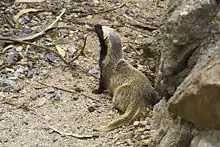





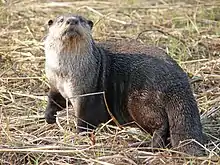

_(25169790524).jpg.webp)






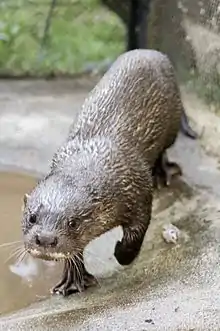
.jpg.webp)




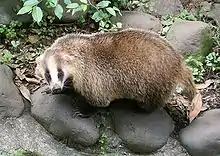




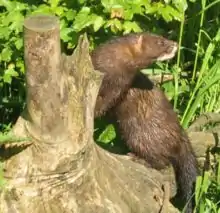
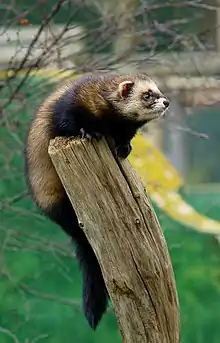


.jpg.webp)
.jpg.webp)
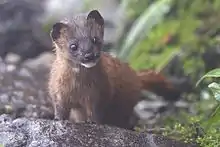
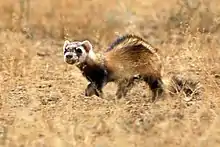

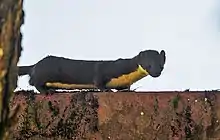
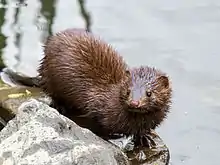
_(20332897078).jpg.webp)
.jpg.webp)